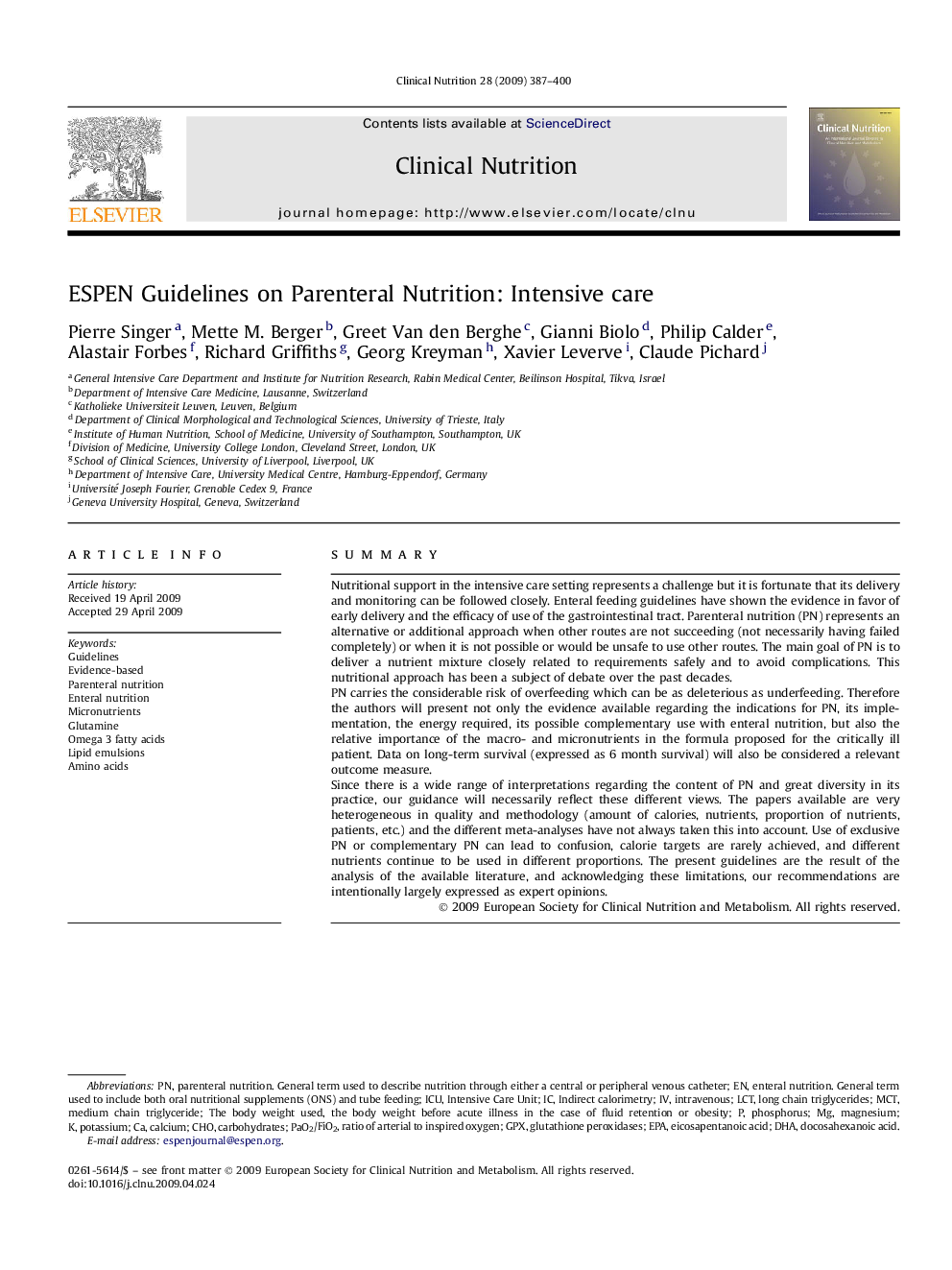| کد مقاله | کد نشریه | سال انتشار | مقاله انگلیسی | نسخه تمام متن |
|---|---|---|---|---|
| 2687406 | 1143017 | 2009 | 14 صفحه PDF | دانلود رایگان |

SummaryNutritional support in the intensive care setting represents a challenge but it is fortunate that its delivery and monitoring can be followed closely. Enteral feeding guidelines have shown the evidence in favor of early delivery and the efficacy of use of the gastrointestinal tract. Parenteral nutrition (PN) represents an alternative or additional approach when other routes are not succeeding (not necessarily having failed completely) or when it is not possible or would be unsafe to use other routes. The main goal of PN is to deliver a nutrient mixture closely related to requirements safely and to avoid complications. This nutritional approach has been a subject of debate over the past decades.PN carries the considerable risk of overfeeding which can be as deleterious as underfeeding. Therefore the authors will present not only the evidence available regarding the indications for PN, its implementation, the energy required, its possible complementary use with enteral nutrition, but also the relative importance of the macro- and micronutrients in the formula proposed for the critically ill patient. Data on long-term survival (expressed as 6 month survival) will also be considered a relevant outcome measure.Since there is a wide range of interpretations regarding the content of PN and great diversity in its practice, our guidance will necessarily reflect these different views. The papers available are very heterogeneous in quality and methodology (amount of calories, nutrients, proportion of nutrients, patients, etc.) and the different meta-analyses have not always taken this into account. Use of exclusive PN or complementary PN can lead to confusion, calorie targets are rarely achieved, and different nutrients continue to be used in different proportions. The present guidelines are the result of the analysis of the available literature, and acknowledging these limitations, our recommendations are intentionally largely expressed as expert opinions.Summary of statements: Intensive CareSubjectRecommendationsGradeNumberIndicationsPatients should be fed because starvation or underfeeding in ICU patients is associated with increased morbidity and mortalityC1.1All patients who are not expected to be on normal nutrition within 3 days should receive PN within 24 to 48 h if EN is contraindicated or if they cannot tolerate EN.C1.2RequirementsICU patients receiving PN should receive a complete formulation to cover their needs fully.C1.3During acute illness, the aim should be to provide energy as close as possible to the measured energy expenditure in order to decrease negative energy balance.B2.1In the absence of indirect calorimetry, ICU patients should receive 25 kcal/kg/day increasing to target over the next 2–3 days.C2.1Supplementary PN with ENAll patients receiving less than their targeted enteral feeding after 2 days should be considered for supplementary PN.C3CarbohydratesThe minimal amount of carbohydrate required is about 2 g/kg of glucose per day.B4Hyperglycemia (glucose >10 mmol/L) contributes to death in the critically ill patient and should also be avoided to prevent infectious complications.B5Reductions and increases in mortality rates have been reported in ICU patients when blood glucose is maintained between 4.5 and 6.1 mmol/L. No unequivocal recommendation on this is therefore possible at present.C5There is a higher incidence of severe hypoglycemia in patients treated to the tighter limits.A5LipidsLipids should be an integral part of PN for energy and to ensure essential fatty acid provision in long-term ICU patients.B6.1Intravenous lipid emulsions (LCT, MCT or mixed emulsions) can be administered safely at a rate of 0.7 g/kg up to 1.5 g/kg over 12 to 24 hB6.8The tolerance of mixed LCT/MCT lipid emulsions in standard use is sufficiently documented. Several studies have shown specific clinical advantages over soybean LCT alone but require confirmation by prospective controlled studies.C6.4Olive oil-based parenteral nutrition is well tolerated in critically ill patients.B6.5Addition of EPA and DHA to lipid emulsions has demonstrable effects on cell membranes and inflammatory processes. Fish oil-enriched lipid emulsions probably decrease length of stay in critically ill patients.B6.6Amino AcidsWhen PN is indicated, a balanced amino acid mixture should be infused at approximately 1.3–1.5 g/kg ideal body weight/day in conjunction with an adequate energy supply.B7When PN is indicated in ICU patients the amino acid solution should contain 0.2–0.4 g/kg/day of l-glutamine (e.g. 0.3–0.6 g/kg/day alanyl-glutamine dipeptide).A8MicronutrientsAll PN prescriptions should include a daily dose of multivitamins and of trace elements.C9RouteA central venous access device is often required to administer the high osmolarity PN mixture designed to cover the nutritional needs fully.C1.3Peripheral venous access devices may be considered for low osmolarity (<850 mOsmol/L) mixtures designed to cover a proportion of the nutritional needs and to mitigate negative energy balance.C1.3If peripherally administered PN does not allow full provision of the patient's needs then PN should be centrally administeredC1.3ModePN admixtures should be administered as a complete all-in-one bagB1.4Full-size tableTable optionsView in workspaceDownload as CSV
Journal: Clinical Nutrition - Volume 28, Issue 4, August 2009, Pages 387–400